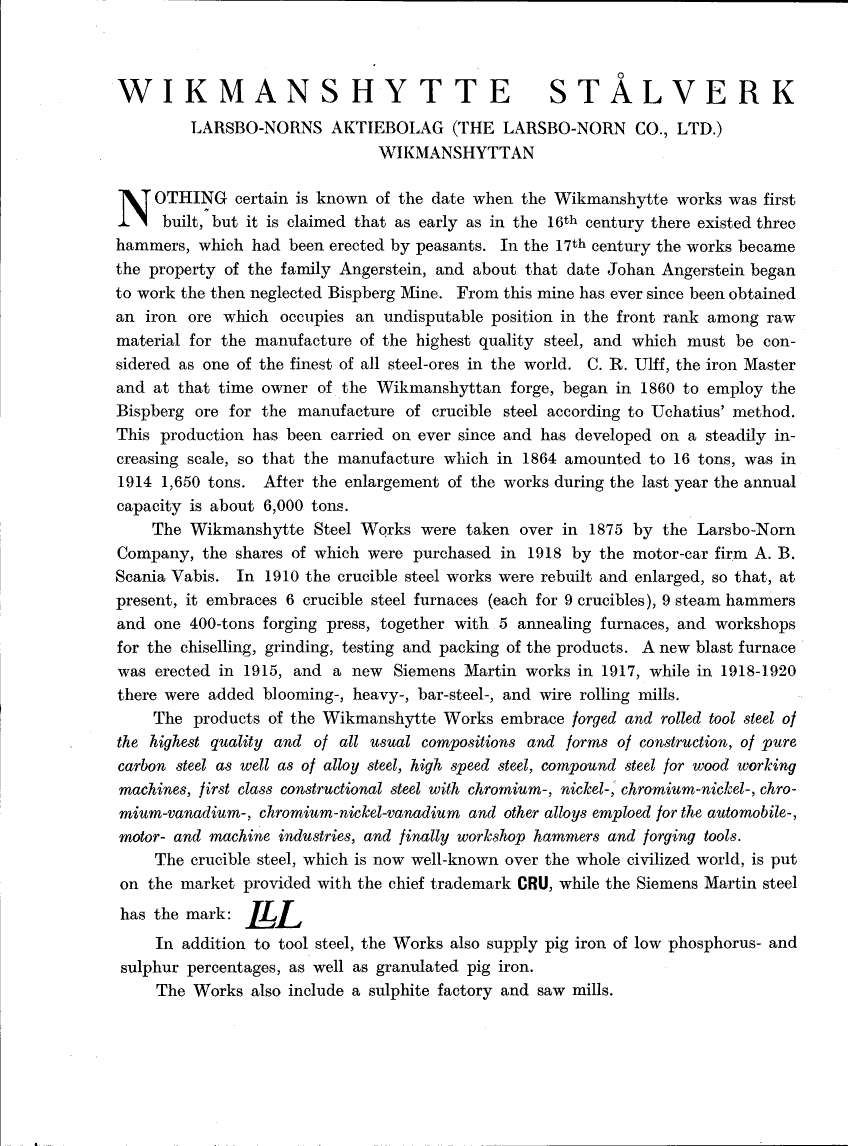
Full resolution (TIFF) - On this page / på denna sida - Wikmanshytte Stålverk. Larsbo-Norns Aktiebolag

<< prev. page << föreg. sida << >> nästa sida >> next page >>
Below is the raw OCR text
from the above scanned image.
Do you see an error? Proofread the page now!
Här nedan syns maskintolkade texten från faksimilbilden ovan.
Ser du något fel? Korrekturläs sidan nu!
This page has never been proofread. / Denna sida har aldrig korrekturlästs.
WIKMANSHYTTE STÅLVERK
LARSBO-NORNS AKTIEBOLAG (THE LARSBO-NORN CO., LTD.)
WIKMANSHYTTAN
NOTHING certain is known of the date when the Wikmanshytte works was first
built, but it is claimed that as early as in the 16th century there existed three
hammers, which had been erected by peasants. In the 17th century the works became
the property of the family Angerstein, and about that date Johan Angerstein began
to work the then neglected Bispberg Mine. From this mine has ever since been obtained
an iron ore which occupies an undisputable position in the front rank among raw
material for the manufacture of the highest quality steel, and which must be
considered as one of the finest of all steel-ores in the world. C. B. Ulff, the iron Master
and at that time owner of the Wikmanshyttan forge, began in 1860 to employ the
Bispberg ore for the manufacture of crucible steel according to Uchatius’ method.
This production has been carried on ever since and has developed on a steadily
increasing scale, so that the manufacture which in 1864 amounted to 16 tons, was in
1914 1,650 tons. After the enlargement of the works during the last year the annual
capacity is about 6,000 tons.
The Wikmanshytte Steel Works were taken over in 1875 by the Larsbo-Norn
Company, the shares of which were purchased in 1918 by the motor-car firm A. B,
Scania Vabis. In 1910 the crucible steel works were rebuilt and enlarged, so that, at
present, it embraces 6 crucible steel furnaces (each for 9 crucibles), 9 steam hammers
and one 400-tons forging press, together with 5 annealing furnaces, and workshops
for the chiselling, grinding, testing and packing of the products. A new blast furnace
was erected in 1915, and a new Siemens Martin works in 1917, while in 1918-1920
there were added blooming-, heavy-, bar-steel-, and wire rolling mills.
The products of the Wikmanshytte Works embrace forged and rolled tool steel of
the highest quality and of all usual compositions and forms of construction, of pure
carbon steel as well as of alloy steel, high speed steel, compound steel for wood working
machines, first class constructional steel with chromium-, nickel-, chromium-nickel-,
chromium-vanadium-, chromium-nickel-vanadium and other alloys emploed f or the automobile-,
motor- and machine industries, and finally workshop hammers and forging tools.
The crucible steel, which is now well-known over the whole civilized world, is put
on the market provided with the chief trademark CRU, while the Siemens Martin steel
has the mark: ^JL/^
In addition to tool steel, the Works also supply pig iron of low phosphorus- and
sulphur percentages, as well as granulated pig iron.
The Works also include a sulphite factory and saw mills.
<< prev. page << föreg. sida << >> nästa sida >> next page >>